Street food is fun! Finding vegan Korean street food, however, can be difficult. In contemporary Korea, the food world is speckled with hidden fish sauce, animal-based soup stock and dairy components (e.g. milk powder, whey, butter), and sometimes even beef tallow or gelatin is added to normally vegetarian breads and dessert! Korean street food provides no exception to the general rule to always be alert. But Korea is not a vegan desert in terms of street food! There are several vegan options, and you do not have to roam the streets hungrily!
Here is your guide introducing possible vegan options, so you can better navigate through the jungle of Korean street food! Learn what street food is vegan in Korea or how it can be veganized. Know your prey first, find your target in the wild and then go catch it! 🏹
In Korea, vegan street food includes basic produce, but also lightly processed foods and a bit more complicated dishes. While some food options are vegan by default, others are occasionally not vegan and you may want to confirm the ingredients in each specific case. ⚠️ For every listed food item, there is a short explanatory text with information about ingredients and the cooking process. Please read the description so you know what to look out for! The descriptions are illustrated with photos as well.
Street food is not any kind of food sold on the street, since Korean road vendors sell a large diversity of things – including uncooked grains, house-made sauces as well as food that is ready to eat. Street food (gilgeori eumsik 길거리음식) are small portions of edibles that can be consumed on the spot. Depending on what you get and where you get it, street food can be a snack on the go or a small meal. [But it’s not necessarily light in calories!] Street food is typically sold outdoors and consumed either on location or as takeaway. 🥡 Getting street food is a very casual way of eating out. Most places selling street food do not have a place to sit but offer space for standing. Larger food stalls, so-called pocha (포차), usually do have simple seating and also a simple roof overhead.
This post covers vegan street food that can be found in Korea, particularly in Seoul. In the illustrated list below, food options are categorized as basic produce and processed dishes with either sweet or savory flavor. Within each category, the vegan food items are listed in alphabetical order. Afterwards, locations of where to generally find Korean street food will be described. At the end of the post, you can find concluding remarks and tips on how to get vegan street food in Korea.
- Table of Contents:
- 🥡 What Street Food is Vegan
- 🗺️ Where to Find Vegan Street Food
- 🔎 How to Find Vegan Street Food
DISCLAIMER: Regarding Korean street food, cross-contamination of vegan foods with non-vegan ingredients is possible at most places. ⚠️ If you are concerned because of cross-contamination or severe allergies, street food may not be the best food option for you. In terms of hygiene and cleanliness, I cannot vouch for a high standard. From personal experience, however, I have never heard about food poisoning from plant-based street food in Korea. In any case, personal discretion is advised.
🥡 Which Korean Street Food is Vegan
🍏 The Basics
Among Korea’s wide array of street food, there are some foods so simple and basic that it is easy to identify them as vegan. Produce such as fruits and vegetables belong to this category. They are more or less unprocessed – merely cooked, steamed, roasted or just served raw!
Chestnuts (bam 밤). 🌰 Roasted chestnuts (gun bam 군밤) are a classic street food in Korea! Small food stalls often sell roasted chestnuts that are peeled and ready to eat. Sometimes, peeled chestnuts are called “nude chestnuts” (nudeu bam 누드밤) to stress that the leathery layer and furry brown skin have been fully removed, making eating more convenient! Usually, chestnuts are roasted on location and they may still be warm when you get them! Because chestnuts are naturally sweet, they are enjoyed just like that – no salt or sugar necessary!
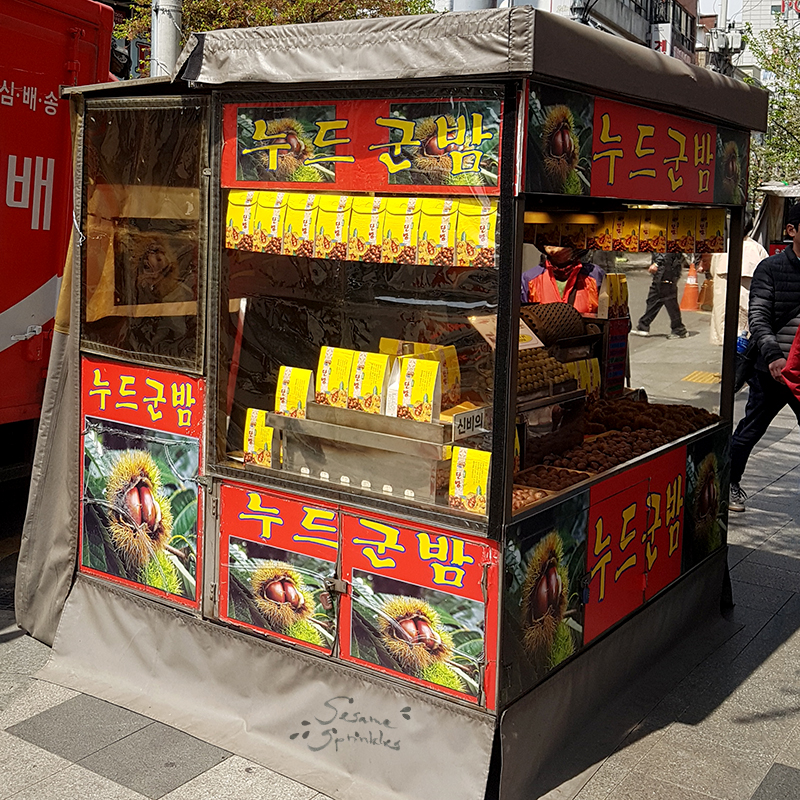
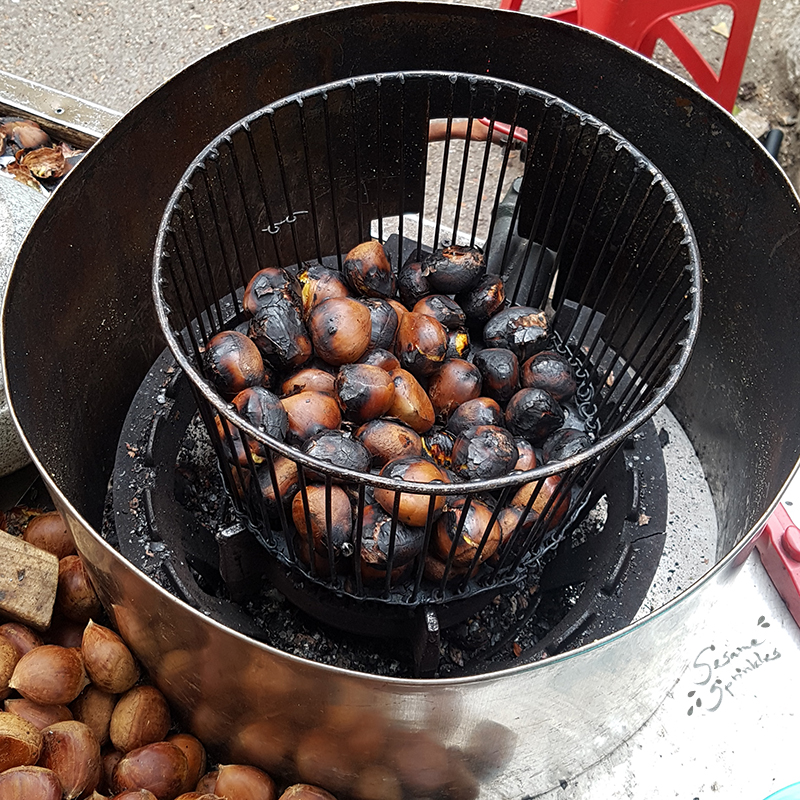
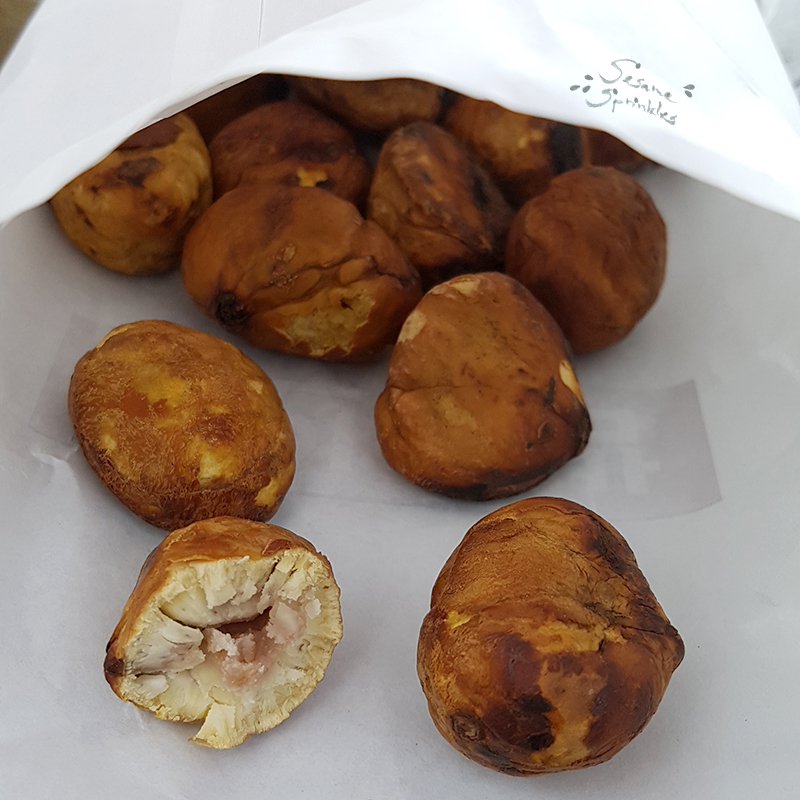
Corn (oksusu 옥수수). 🌽 In Korea, corn on the cob is a simple yet ever-present snack, which is also sold as street food. You can see it steamed, cooked or roasted at small food stands and food trucks. Most common is steamed corn (jjin oksusu 찐옥수수), which is a reliable vegan option, and it may come in all kinds of corn colors. Roasted corn (oksusu gu-i 옥수수구이 / gun oksusu 군옥수수), on the other hand, may have been coated with butter during or after the roasting process. ⚠️ In Korea, corn on the cob is usually eaten as it is, i.e. without salt, sugar or any other additional seasoning!



Fresh fruit (saeng gwa-il 생과일). 🍇 This seems like a no-brainer, but Korea has its own local customs regarding fruit as street food. Only certain fruit are peeled, cut up and served inside a cup or on a skewer. In the summer months, you may see for example pieces of pineapple (pa-in aepeul 파인애플), watermelon (subak 수박) or melon (meron 메론). 🍍🍉🍈 In rare cases, you may see native fruits such as mulberries (odi 오디), Korean raspberries (santtalgi 산딸기) or Korean blackberries (bokbunja 복분자) sold in small portions. 🍇



Ginkgo nuts (eunhaeng 은행). 🟡 With some luck, you can find ginkgo seeds, which are traditionally a precious food item in Korea, sold by road vendors! As a street food, the yellow seeds of ginkgo trees are roasted (eunhaeng gu-i 은행구이) and filled into small cups or paper bags. Roasted ginkgo seeds have a soft texture and the characteristic flavor of ginkgo nuts, alongside a slightly bitter and nutty taste.
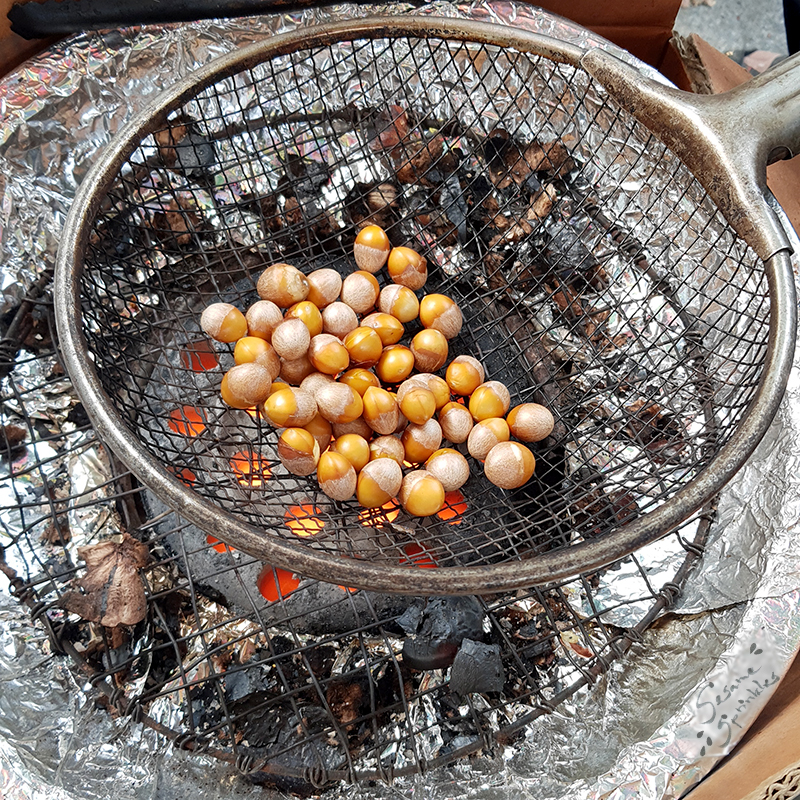

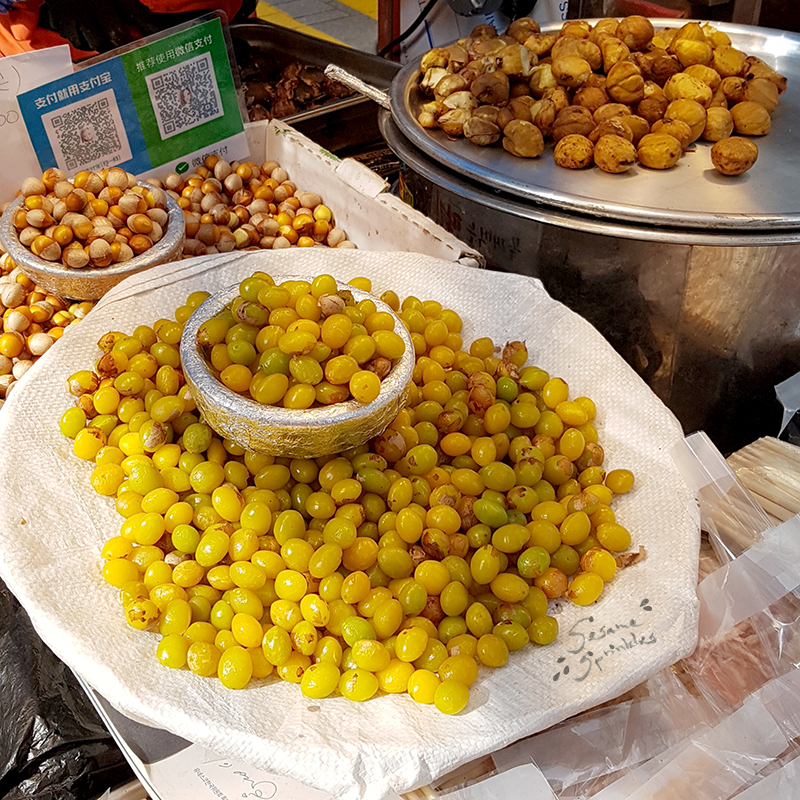
Potatoes (gamja 감자). 🥔 Similar to corn and sweet potatoes, Koreans tend to enjoy potatoes as a snack. You can see cooked or steamed potatoes offered as street food, in which case they will be vegan. There are also small whole potatoes (al gamja 알감자 / tong gamja 통감자), which are either pan-fried or deep-fried. When fried in butter, they are vegetarian, but when fried in vegetable oil, they are vegan. ⚠️ As a snack or street food, potatoes are served with sugar or with salt in Korea.



Sweet potatoes (goguma 고구마). 🍠 Sweet potatoes are a popular street food that is available steamed, cooked or roasted all year round. Particularly in winter, roasted sweet potatoes (gun goguma 군고구마) are an ideal street food that is not only vegan by default but that can also warm hands and belly! Sometimes they are still steaming hot, so be careful not to burn yourself!



🍬 Sweet Street Food
Certain street foods lure you in from a distance, e.g. with a mouth-watering scent of vanilla, caramel or cinnamon… 👃 These are the street foods that can serve as dessert or a sweet snack! Although famous Korean street foods such as waffles (wapeul 와플), bungeo ppang (붕어빵), hodu gwaja (호두과자) and deli manju (델리만주) are not vegan, there are still a couple of vegan-friendly sweet treats! Anyone with a sweet tooth will find them hard to resist! 😋
Dalgona (달고나). 🍭 Dalgona is Korea’s name for a toffee candy. It is often a flat disk, either sold on a stick or by itself, which is decorated with an image. Modern dalgona may have different shapes representing e.g. animals, flowers or cartoon characters. Dalgona is made by melting and caramelizing sugar together with a small amount of baking soda. The resulting toffee has an airy and crunchy texture and tastes like caramel. It is also very brittle and breaks easily! 💔 Since it consists basically only of sugar, it is vegan and gluten-free! Originally, dalgona was made on location in a metal ladle over a small fire. In recent years, however, observing the process of making dalgona has become a rare sight in Seoul…

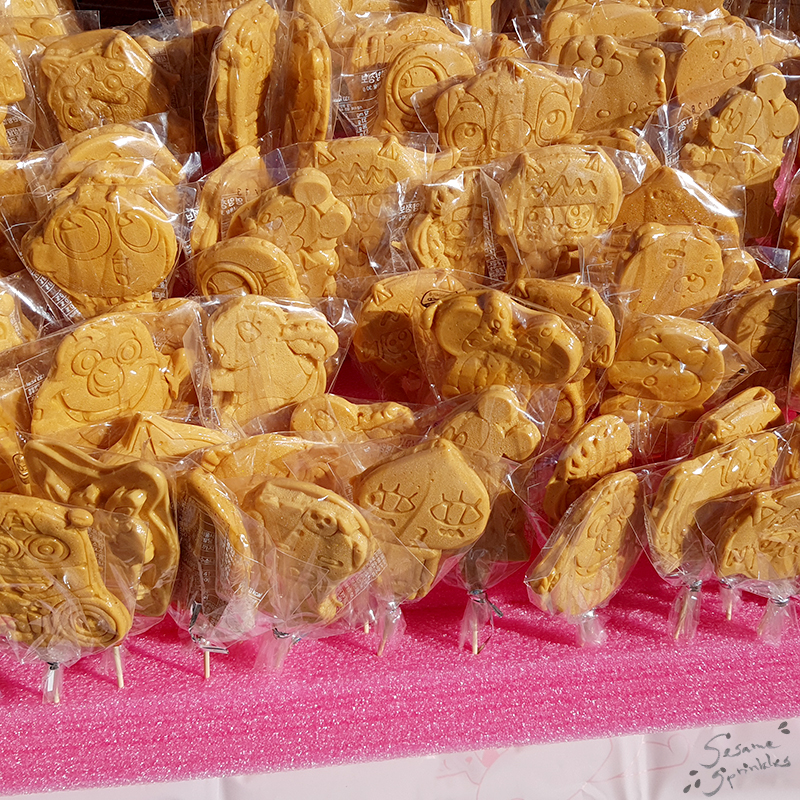

Fresh fruit juice (saeng gwa-il juseu 생과일주스). 🥤 In addition to cut fruits, fresh fruit juices are a hydrating snack as well! There are road vendors who specialize in making fruit juice on location. Unless it is actual pressed juice (chakjeup juseu 착즙주스), which is available as well, so-called “fresh fruit juice” (saeng gwa-il juseu 생과일주스) is often a kind of smoothie made in a blender. A vendor may add ice cubes, water and a sweetener before blending the fruits. You might want to check whether honey or another syrup is used to sweeten the juice (smoothie). ⚠️ (Honey being more expensive in Korea is seldom used, though.) Since fresh fruit juices are made to order, you can always ask to not add any sweetener (vegan or not) – according to your preference! 🚫🍯



Hotteok (호떡). 🥞 Hotteok is a common and popular street food in Korea, but it is not always vegan because the dough may contain milk or milk powder. ⚠️ Depending on the individual recipe or the pre-made mix used by the road vendor, hotteok is sometimes dairy free. If you speak Korean, you can ask whether it contains any dairy components. Particularly hotteok with special flavors like black rice, corn or green tea contains dairy. Hotteok are filled pancakes made from yeast-leavened dough. The classic version is sweet and contains a syrupy filling, usually consisting of sugar, cinnamon and peanuts, sesame or other seeds. Balls of dough are filled and then fried in oil. While frying the dough, it is pressed down so that it becomes flat and round. Hotteok is generally a greasy dessert, but depending on who makes it, it’s sometimes even deep-fried! When made fresh, hotteok is very hot and you have to be careful not to burn your mouth with the liquid filling! 👅🔥
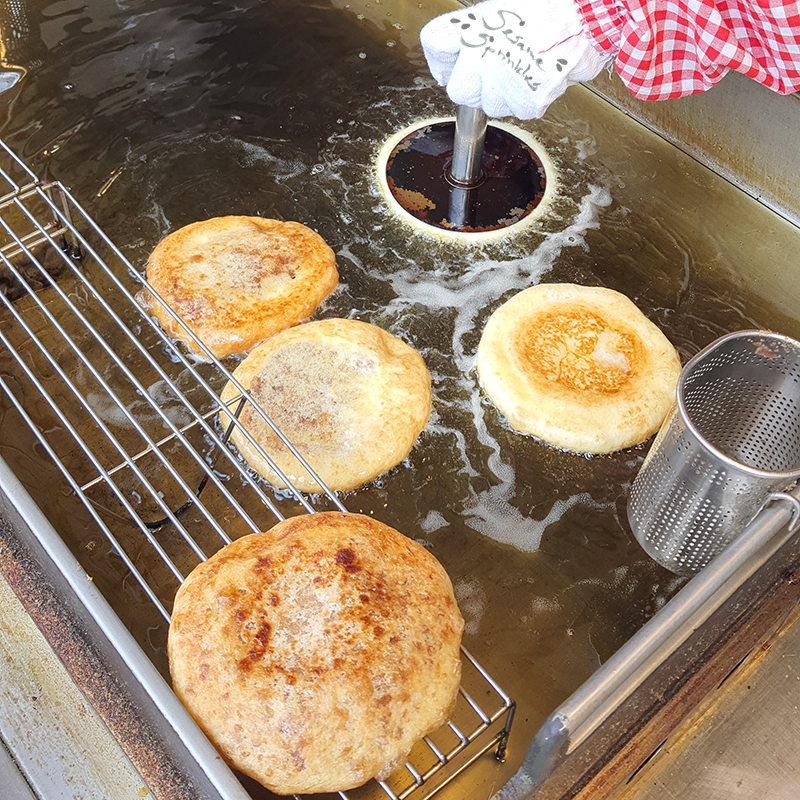


Mattang (맛탕). 🍟 Mattang is a sweet treat that can be described as deep-fried and caramelized sweet potato. 🍠 Ideally, pieces of sweet potato are deep-fried until they are lightly browned, and then coated in caramelizing sugar, which gives them a crispy shell. Cheap versions use deep-fried pieces of sweet potato and simply drizzle them with syrup. [Tastewise, the latter is not recommended!] Anyways, it is typically a very sweet snack!



Sikhye (식혜). 🥤 Technically a drink, yet filling is sikhye (식혜). This is a traditional Korean drink made by fermenting cooked rice with malt. 🍚 The liquid snack is buff colored and there are visible rice grains floating in it. Sikhye is served cold, sometimes even as icy as a slushie! It is very sweet and a refreshing treat during the warmer season!



Susu bukkumi (수수부꾸미). 🥞 Half-moon shaped susu bukkumi (수수부꾸미) is a pan-fried treat that is made primarily of sorghum and filled with sweet bean paste. In addition to sorghum, the dough sometimes contains glutinous rice flour. It is a traditional, vegan and gluten-free dessert. Because of its soft and chewy texture, it may resemble Korean rice cakes. Susu bukkumi is best enjoyed warm, and you can find fresh bukkumi as street food at some places in Seoul. It is originally a local speciality from the province Gangwon-do (강원도). Street vendors may ask you whether you want “honey” or syrup with it. It is generally unlikely that real honey is used. 🍯 Instead, the yellowish liquid is in most cases rice syrup (jocheong 조청), corn syrup (mulyeot 물엿) or oligosaccharide syrup (olligodang 올리고당).


Tanghuru (탕후루). 🍡 Actually, tanghuru (탕후루) is a street food with Chinese origins (tánghúlu 糖葫芦 / 糖葫蘆). Lately, tanghuru has entered Korea’s street food scene and established itself in areas outside Korea’s Chinatown in Incheon! The dish features fresh fruit on a skewer, which are coated with a crust of melted sugar. In Korea, tanghuru is most often made with strawberries, but it can include other fruits as well, e.g. grapes, tangerines, pineapple, blueberries and cherries. 🍓🍊🍇🍒🍍🥝 Naturally, this snack is very sweet because of the hardened sugar coating, which is crunchy when you bite into it! As long as the coating is not red, tanghuru is plant-based. If red food coloring has been used, chances are it is cochineal, which is derived from insects. ⚠️



Yeot (엿) and pumpkin taffy (hobangyeot 호박엿). 🍬 In Korea, there are various kinds of malt candy, so-called yeot (엿), but pumpkin yeot (hobangyeot 호박엿) is sold on the street most often. 🎃 It may be described as chewy candy or taffy, but Korea’s yeot is made from starch fermented with malt and traditionally vegan. The base used to be 100% rice, but modern manufacturers may use other grains. Be careful with mass-produced yeot from factories, because those sometimes contain additives such as whey powder, eggwhites or gelatin! ⚠️ [In case of factory-produced yeot, make sure you check the ingredient list on the package! ] Naturally, yeot tastes very sweet and it is quite chewy. In fact, it can actually be hard to chew and stick to your teeth, but it will slowly melt in your mouth! Regular yeot, which is normally shaped like a stick, is harder and less chewy than pumpkin yeot. Traditionally, pumpkin yeot was sold by a professional yeot maker (yeotjangsu 엿장수), who would rhythmically hammer a large slab of yeot into bite-sized pieces with a chisel while singing!!! 🎵 Unfortunately, I have not seen such a performance in Seoul for many years… But maybe they still exist on the countryside?



🧂 Savory Street Food
Korea also offers a large number of street food that is savory and more filling than sweet treats. Certain types of street food become anju (안주), when combined with alcoholic drinks! In such a case they are a night-time snack which is enjoyed outdoors. 🍶
Gireum tteokbokki (기름떡볶이). 🍲 Tteokbokki with a red-colored sauce is a common Korean street food, but it is not vegan! It contains a flat variety of fish cake (odeng 오뎅) and is seasoned invisibly with fish-based broth. ⚠️ However, there is a variety of tteokbokki that is vegan-friendly: Gireum tteokbokki (기름떡볶이), which translates to “oil tteokbokki“. This is a specialty of Tongin Market (통인시장) in Seoul, where a couple of food stalls offer it. As the name suggests, gireum tteokbokki is very oily, because the rice cakes (tteok 떡) are fried in oil. It does not have a liquid sauce like regular tteokbokki, but it is seasoned with either soy sauce or chili. Note that the chili-flavored gireum tteokbokki can be very spicy! 🌶️

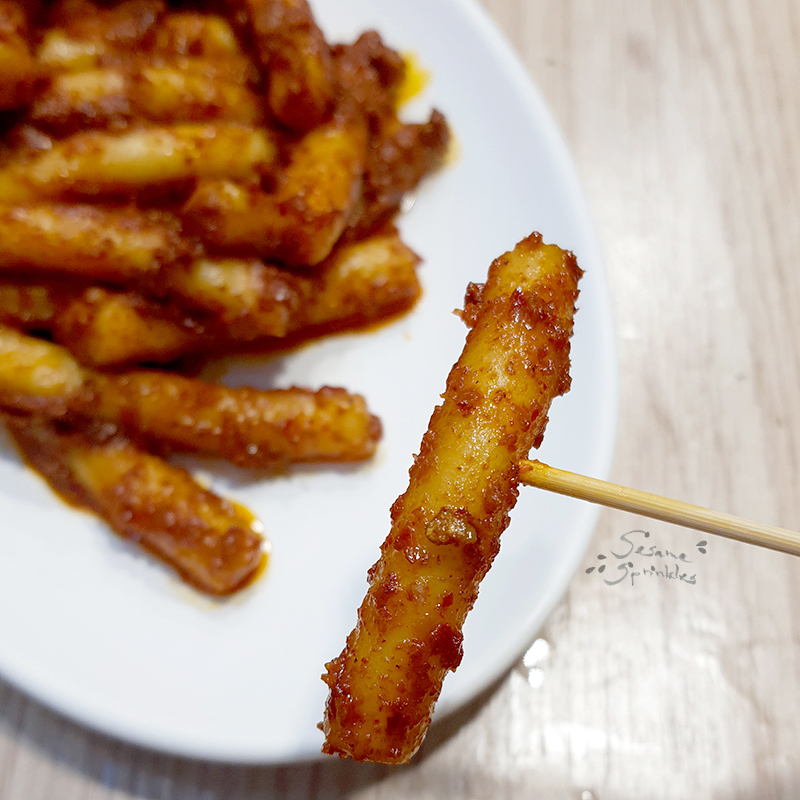

Roasted Tteok (tteok gu-i 떡구이). 🍡 Korean rice cakes are diverse in color, shape and flavor. The most basic rice cake, which is called garaetteok (가래떡), is frequently used in savory cooking. Also several street food dishes feature garaetteok! Whole sticks of large garaetteok roasted over hot rocks or coals are sold as garaetteok gu-i (가래떡구이) or tteok gu-i (떡구이). 🔥 Roasted garaetteok is a bit crunchy on the outside, chewy inside and tastes rather bland without seasoning. If you like the mild flavor of plain rice with light roasted aromas, you can enjoy it as is. Otherwise, it can be combined well with sweet syrup or a savory sauce.



Tteok-kkochi (떡꼬치). 🍡 Another vegan Korean street food featuring garaetteok is tteok-kkochi (떡꼬치), plain rice cakes on a skewer! The white rice cakes, which are a small version of garaetteok, are deep-fried until they turn beige. The deep-fried rice cakes are combined with a red sauce, which tastes sweet and spicy. 🌶️ Some food stalls let the skewers sit in sauce all day or coat them entirely with sauce, which makes the rice cakes soft and soggy. Other vendors brush the sauce onto the rice cakes only lightly, so that the texture of the deep-fried tteok is preserved better.



Savory pancakes (jeon 전 / buchimgae 부침개). 🥞 Korean cuisine includes a variety of savory pancakes (jeon 전 / buchimgae 부침개), which are also available at outdoor food stalls. Depending on the recipe of the individual vendor, the pancake batter is either vegan or it contains egg and other animal-based ingredients. ⚠️ A classic vegan-friendly pancake is gamjajeon (감자전), Korean potato pancake, which is also gluten-free. Some Korean mung bean pancakes, aka bindaetteok (빈대떡) or nokdujeon (녹두전), are made only with mung beans and vegetables, while others are topped with meat or seafood. Unless the batter contains egg, garlic chive pancakes (buchujeon 부추전) and plain scallion pancakes (pajeon 파전) can be considered plant-based as well. It is best to ask and confirm the ingredients before you order.


Small kimbap (kkoma kimbap 꼬마김밥 / mini kimbap 미니김밥). 🍣 In Korea, kimbap is the most common snack and outdoor meal. And guess what, many street food stands offer kimbap as well – but a small version of it! Kkoma kimbap (꼬마김밥 ) or mini kimbap (미니김밥) are small wraps of rice and sea laver. Because the fillings differ by vendor, kimbap is not always vegan. ⚠️ You need to check whether the filling contains fish cake, ham or egg! If the kimbap is rolled on location, you could ask to customize your order. Another variety is mayak kimbap (마약김밥), which is small kimbap served with a special dipping sauce.


Vegetable-based Twigim (튀김). 🍟 In Korea, a lot of savory street foods are deep-fried. One category of deep-fried foods is twigim (튀김), which includes various vegetables but also seafood, sausages and eggs. 🍤 If the frying batter has not been made with egg and is thus plant-based, then vegetable-based twigim is vegan-friendly. ⚠️ Normally, the batter is a combination of wheat flour, rice flour, onion and garlic powder and does not contain egg. Potentially vegan options are mixed vegetable twigim (yachae twigim 야채튀김) 🍟, sweet potato twigim (goguma twigim 고구마튀김) 🍠, potato twigim (gamja twigim 감자튀김) 🥔 and sweet pumpkin twigim (danhobak twigim 단호박튀김). 🎃 Twigim is usually eaten with a seasoning sauce, and you can dip your selection of deep-fried items into the seasoning to your liking. Keep in mind that the plant-based options are fried alongside other foods, i.e. they have been in the same oil as meat or seafood, and cross-contamination is highly likely.


🗺️ Where To Find Street Food in Korea
📍 Common Street Food Locations
Korean street food is obviously sold at the side of the street, but it can also be found on traditional markets or at highway rest areas. 🚌🚙 Road vendors tend to be in front of train stations, inside or outside subway stations, along large roads, on lively intersections, inside parks or at the entrance of hiking areas. 🚋🛤🚗🛣🚶♀️🚶🏞🥾

Some vendors specialize in only one type of street food, whereas others make different kinds of dishes at once. For instance, food stalls offering tteokbokki usually have twigim as well as other savory street food, because the dishes supposedly go well together. 🍲🍟
A place selling street food is generally called pojang macha (포장마차) in Korean. The term pojang macha derives from the words pojang (포장) meaning “packing, wrapping” and macha (마차) “cart”. Subsequently, it was originally a vehicle selling food for takeout. 🥡 Today, some food carts are mobile, but most have a fixed location. While you can still get food for to go, you can also eat it on location. There are larger food stands, where you can even sit down and have food alongside alcohol, in which case they are referred to as pocha (포차; an abbreviation of pojang macha). Apart from their larger scale, pocha are also characterized by a thin roof or tent-like cover, allowing customers to enjoy food outdoors despite cold or rainy weather. ⛺🎪
There can be individual food stalls or groups of food stalls. Areas in which street food stalls are lined up next to each other can be referred to as pojang macha geori (포장마차 거리) or pocha geori (포차거리; literally “pocha corner”). ⛺️⛺️⛺️⛺️
Occasionally, small restaurants are named “pocha” even though they are indoors. Spending a night-out drinking at a pocha has its own charm and a special atmosphere, which is also recreated in Korean movies and TV dramas. 🌃
In Seoul, there are a couple of locations that are particulary friendly towards vegans and vegetarians: At Gwangjang Market (광장시장), Seoul’s oldest permanent market, you can find comparably many vegan options, e.g. susu bukkumi, vegan-friendly bindaetteok and mayak kimbap. Tongin Market (통인시장), which is another traditional market, offers gireum tteokbokki, tteok kkochi, mattang and more! The shopping areas of Insadong (인사동), Hongdae (홍대) and Myeongdong (명동) are also dotted with food stalls that sell both traditional as well as modern Korean street food, some of which are vegan.
🌱 Veganized Korean Street Food
There are many more street food dishes than those listed above! However, most of them are not vegan. But it is possible to find veganized versions of typical Korean street food! 🌱
At present, there are only a few vegan eateries that serve street food in Seoul. Maru Jayeonsik Kimbap (마루 자연식 김밥) and Vegan Insa (비건인사) have a couple of veganized street foods, e.g. vegan tteokbokki (떡볶이), vegan dumplings (mandu 만두) 🥟 and vegan fish cake (bigeon odeng 비건오뎅 / bigeon hatba 비건핫바). 🍥 Cow Tteokbokki (카우떡볶이) is not a vegan restaurant, but it specializes in tteokbokki and offers a variety of veganized tteokbokki as well as twigim! 🍲🍟

In addition to that, some food companies are producing vegan versions of street food classics such as tteokbokki and Korean hot dog (hat dogeu 핫도그; actually a Koreanized version of a corn dog). You may find such instant foods in large supermarkets, online or at one of the vegan food stores in Seoul.
.
.
.
🔎 How to Find Korean Vegan Street Food
As you can see, there are plain, sweet as well as savory options among the vegan street foods in Korea. Basic produce is easiest to identify as vegan. But vegans can eat more than the one-ingredient dishes! While some vegan street food options are raw, others have been roasted, steamed or deep-fried! Whatever taste you may be craving, you should be able to find something that satisfies your appetite!
Besides having an appetite, you most likely need cash for hunting street food! 💵 Many small food stalls still operate without a card reader, so having cash at hand is advisable! 💳 Some places have begun accepting online bank transfers, but unless you have a Korean bank account, this service may not be an alternative for you. Although prices have gone up in recent years, street food is still cheaper than eating at a restaurant.
If you want to find vegan street food in Korea, you can consider it a hunt. 🏹 Many road vendors are not stagnant! Some of them change locations daily or visit only on specific days of the week. Others disappear from the usual hunting grounds when the weather is bad. Certain street foods are only availbale during a certain season. Also, the repertoire of street food vendors is changing over time: One year, there may be a trend for one kind of food and the next year, it may have disappeared!
Regarding the time of activity, the opening hours of road vendors vary individually. In general, most street vendors are closed before noon and begin operating in the afternoon. Pocha, in particular, may operate in the evening until late at night, since they offer food and alcohol.
Some last words of advice on how to get vegan Korean street food:
Regarding street food based on dough, many road vendors use dough or batter mixes from big food companies. The ingredients vary by producer, so at times you can find a vegan version, while other vendors use premix (peuri mikseu 프리믹스) from a different company that contains animal-based ingredients. Oftentimes old-fashioned and hand-made foods are less likely to contain dairy.
Since recipes vary by producer and some street foods are not vegan by default, it is best to inquire about ingredients before purchasing it. Many road vendors do not speak English, so having basic Korean language skills is always a plus. 🗣🇰🇷 This enables you to customize food or ask questions about the ingredients.
After all, a word of caution. Be aware that vendors’ statements cannot be trusted all the time. People are not always open about what ingredients they use in their food (maybe because they want to protect their business). So it helps to ask about allergens or point out that you are inquiring because of a food allergy (rather than appearing like you want to steal their recipe). Regardless, be it because of language barriers or cultural differences, there can be miscommunication or misinformation. Please use your best judgement.
.
.
✍️ This compilation of vegan-friendly street food is not complete! More options will be added as they are discovered and ingredients are analysed! ✍️
❓ Is there a street food that you would expect to see in this list? Let’s check whether it is vegan!
❗️ Tell me about it by sending me a message or commenting below! 👇
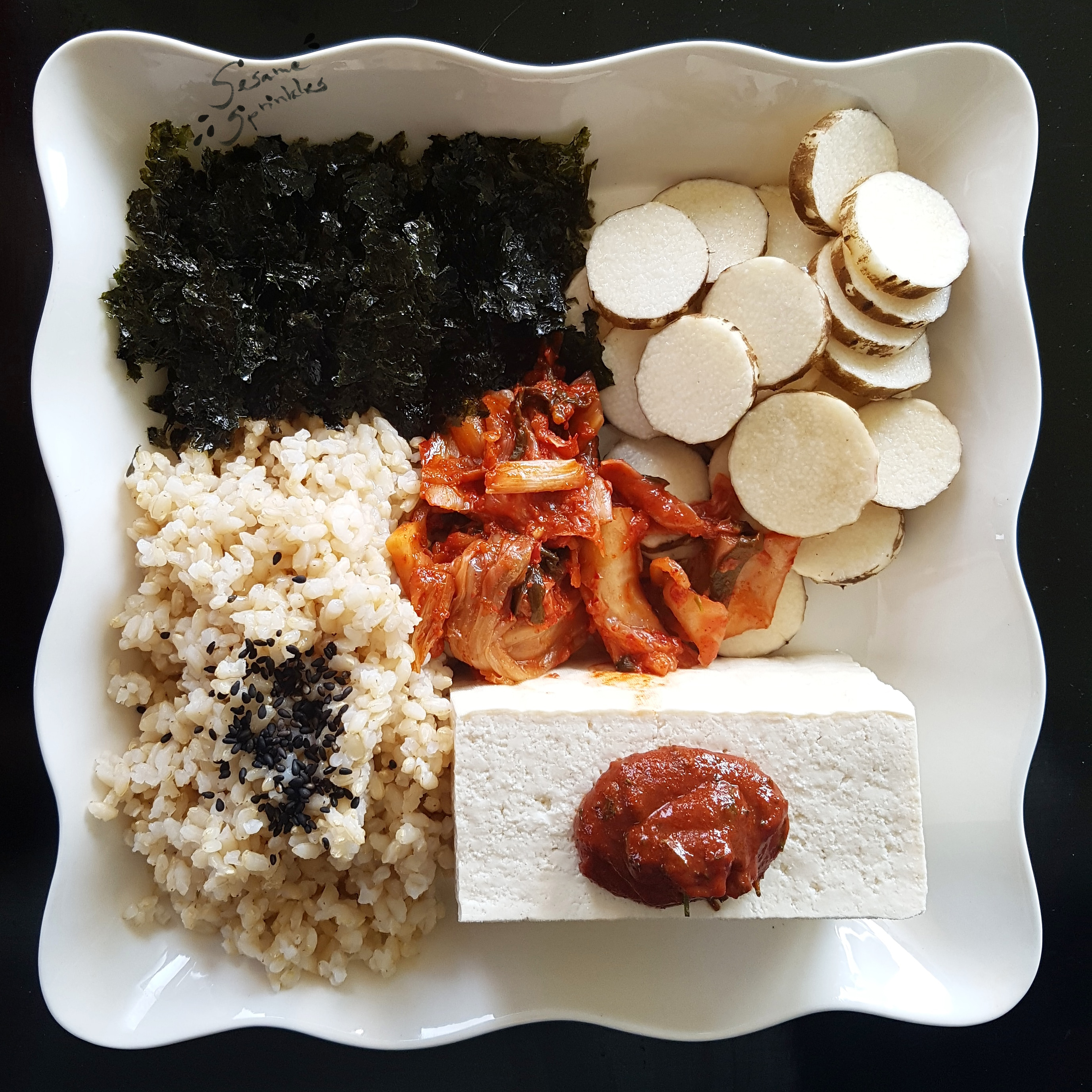











감사함니다!! What an informative article! I’ve been to Korea twice and was afraid to try much street food (or resigned to ingesting a bit of dairy). This is so helpful and I can’t wait for our next visit with family there in 2024! I want to visit one of the markets you’ve written about. Now…to wonder if any of the pocha serve non-alcoholic drinks as well as the usual ones. I would love to enjoy food and drinks at one of those covered places with our Korean family. Thank you again!! From a fellow vegan foodie! 💗
LikeLike
Hi! Thank you for such much of information!
Maybe I can add a bit to it? https://www.facebook.com/groups/chaesik/posts/10168537405095319/
LikeLike
Hi! Maybe you or others would check the ingredients list of churros. In Spain it’s usually made from 3 ingredients: flour, oil, water. I don’t know about Korean’s versions cos I never tried it. I was in Spain 2 months ago so I wasn’t intrested in churros in Korea ahah.
LikeLike